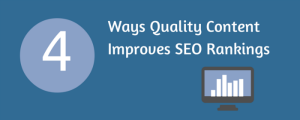While search engine optimization gets all the notoriety and attention, website optimization actually yields better results. Here’s how to do it.

The terms search engine optimization and website optimization are often used interchangeably. But they are different.
It brings to mind the mistaken interchangeability of the terms inbound marketing and content marketing. They have a lot in common. But content marketing is a subset of inbound marketing.
The same is true with search engine optimization and website optimization.
According to Wikipedia “Search engine optimization (SEO) is the process of affecting the visibility of a website or a web page in a search engine’s “natural” or un-paid (“organic”) search results.”
Website optimization, however, has to do with getting the right people to your site (SEO), AND what to do with them once they get there.
So just like content marketing is one element of inbound marketing, search engine optimization is a subset of website optimization. But the majority of people still think that “website optimization” means ranking at the top of a search engine.
The distinction is important, because to many companies and marketers, SEO gets most of the attention. Most SEO efforts are focused on following the ever-changing nature of search engine algorithms. With over 200 ranking algorithms in Google’s system, it’s easy for the practice of SEO to get wrapped up in the details.
Instead, the focus should be on the searcher first (i.e. the human), and the search engine second. That’s the nature of website optimization and why it is so important and effective.
When optimizing your website, yes, you need to follow search engine optimization best practices, but more importantly, you should think about user experience, lead conversions, and acquiring customers. Happy searchers make for happy search engines.
Google only loves you when everyone else loves you first. ~Wendy Piersall
When it comes to a searcher, one of the most important things to remember is that they are people. They are looking to avoid pain or seek pleasure in the form of your product or services. They are searching in order to accomplish something, learn something or to navigate to something.
That’s why the cornerstone of successful website optimization is focusing on your buyer persona.
According to Adele Revella of Buyer Persona Institute, “Buyer personas are examples of the real buyers who influence or make decisions about the products, services or solutions you market. They are a tool that builds confidence in strategies to persuade buyers to choose you rather than a competitor or the status quo.”
For website optimization, buyer personas help you to
- Create a website experience that “speaks” to them
- Use the right lingo
- Create marketing content and offers that interest them
- Guide them along a specific path on your website
- Encourage meaningful alignment for your entire company
Three additional means of optimizing your website for searchers and search engines include:
- Website Design – Great website design is based on cognitive fluency, or the ease of which something is processed. Google researchers found that not only will users judge websites as “beautiful” or not within 1/50th – 1/20th of a second, but also that “visually complex” websites are consistently rated as less beautiful than their simpler counterparts.
- Content, Topics And Keywords – Each website page should be built around a central topic or keyword. Think about your buyer persona’s search queries and language and give them what they want. Answer their questions and then guide them to the next logical step in their research phase (and your sales process).
- Content Format – There are five key areas of on-page SEO that you can control and which are critical toward optimizing your website’s ability to get found.
- Page Title – Include your keywords here, think of it like a magazine title. This is more important to the search engine than the website visitor, but don’t overlook this.
- URLs – Include dash-separated keywords here to help the search engines.
- Page Headers – These are more important to the search engine user than the search engine. When the visitor gets to your page it signals that they’ve reached the right place, in part because they likely were using search terms similar to what appear in the page’s headers.
- Content – This can be text, video, images, slide presentations. It is your chance to fully and comprehensively discuss the topic for which the visitor was searching. Don’t stuff keywords here (you won’t fool the search engines), but do include synonyms and alternate phraseology for the searched topic.
- Meta Description – This is the short description visible on the search engine results. It has no effect on the search engine algorithms but the person searching often reads it before deciding to click on the link.
One more tip – your website optimization should really never stop. Ongoing analysis and measurement of your website analytics will provide you with ample feedback to make sure you’re making the searchers (and the search engines) happy.
Read more
(342)
Report Post






